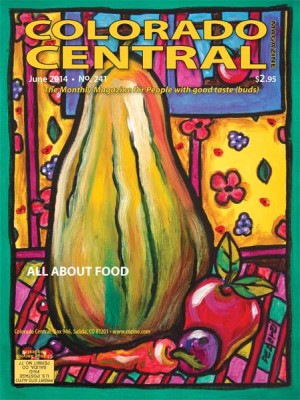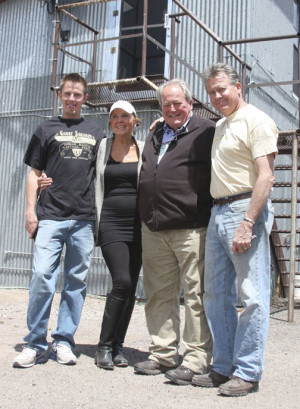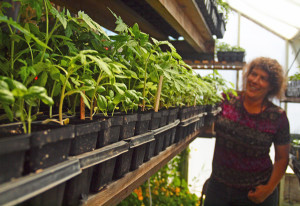By Polly Oberosler
Up until the 1950s, water running through small ranches in the Gunnison Valley and other rural areas in western Colorado were destinations for fisherman from the Front Range. Nearly every ranch had a cabin or two where the fisherman came to set up “housekeeping” for a few days, and the ranchers had gardens to supply them with fresh foods they may have run short on.
The Gunnison Valley, although blistering cold in winter and having a mighty short growing season, can produce many varieties of garden foods every summer that are second to none. The rich soil and cool nights are ideal for growing more than just incredible hay. The plants at altitude take on a persistent attitude, much like the residents who grow them, passing on the strong genes for a hearty life coaxed into existence by unimpeded sunshine and good clean water. The plants grow with gusto knowing nature’s clock is against them, sucking up nutrients from the soil in record quality and time.
The early rural population of Gunnison County did what they could to make a living, especially during the Depression; many were part time farmers along with producing quality hay and beef. They even shipped produce on the railroad that ran from Gunnison over Marshall Pass and into Salida. They sold their summer crops to markets in Pueblo, Denver and Colorado Springs where the high altitude produce was coveted. Those early residents grew strawberries, potatoes, turnips, carrots, wheat, barley, oats, broccoli, cauliflower, peas and even corn, to name a few. As long as they kept the garden in full sun and in the moist bottom lands, they were in business. My own relatives raised a few head of cattle to complement their living, and in the fall my mother and grandmother would spend days making tamales with the beef and ship them to the mining camps near Leadville and Cripple Creek. The fish hatchery at Roaring Judy would wrap fish in newspapers, freeze them and ship them via railroad to the Front Range.
When I was a kid there were around four dairies in the Gunnison area; I can still recall the wonderful smell of fresh cream at the Gunnison Creamery, where my family bought milk and ice cream for their store, and I can still visualize the Walker Dairy north of Gunnison. If you lived on a rural place, you had chickens and probably a pig – the garbage disposals of the day. No one in the rural communities had a need to buy much at the little markets in town, except for the few things that you could not grow or barter for with a neighbor. That lifestyle vanished over about a twenty-year period as supermarkets came on the scene and we started buying our food miles from its origin and in many cases, across the world.
Today there is more and more awareness of the origins of our food and the benefits of eating locally and regionally grown foods. That trend is most obvious in the smaller communities of the Western Slope where beef co-ops have formed and produce co-ops are making a resurgence. Smaller retail markets are springing up on main streets across Colorado in which the owners are trying to buy locally and offer foods that are grown without chemical enhancements. Year-round greenhouses are visible in backyards as testament to the desire of many to be more self-sufficient.
Currently in the Gunnison area, there is a grassroots effort to bind all of the players together so that we might all have fresh foods that are locally grown. The nonprofit Mountain Roots Food Project was formed in 2010 to try to help nurture the growth of locally produced foods. They already have seven local gardens that maximize resources and help people get started in gardening as well as teach them land ethics and how they are tied to the land. Western State Colorado University has been on board for a long time trying to utilize locally grown foods in campus facilities, but it often faces deep-seated regulation; this is slowly changing. A few ranchers have tried to sell their beef locally to a sometimes fickle market, but they are gaining ground by setting up storefronts and selling to local restaurants. Mountain Roots puts food on the plates of schoolchildren in their “farm to school” program, and it sponsors programs year-round that serve to educate young and old about good locally grown foods.
Good food, grown with clean water and soil, is our life blood. It is the one common denominator we all share, and the more we understand how important it is in fighting disease and illness, the faster we can turn around autoimmune diseases and overall health.
As folks are exposed to the taste of fresh beef from the local market, produce that has not been shipped from Mexico and pork grown outside of concrete cubicles, they will begin to partake, and the persistence of the farmers will pay off. There is no going back once you have eaten fresh lettuce from your garden or a producer who uses just the sunshine and native soils to grow their crops. I am glad to see people coming back to the land; the closer they are tied to it, the more respect the land will be shown.
Polly grew up in Gunnison County and spent much of her time as a kid picking rocks with her Dad so her family could carve a living out of the land and maybe even grow something.




